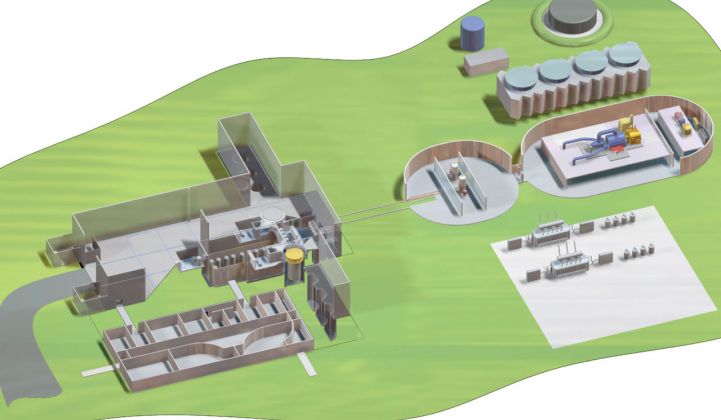A company touting a new nuclear reactor design landed CAD$5.3 million ($4 million) last month to complete the first phase of its vendor design review.
The Series A funding achieved by Canadian firm Terrestrial Energy, from unnamed investors, added to a March grant of CAD$5.7 million ($4.4 million) from the Canadian government to bring the company’s total fundraising to CAD$22.5 million ($17.2 million) so far.
Terrestrial Energy is looking to use the money to commercialize an Integrated Molten Salt Reactor (IMSR) design based on Manhattan Project-related research carried out in the 1960s at the Oak Ridge National Laboratory, Tennessee.
Unlike traditional reactors, IMSRs have a liquid fuel: radioactive materials are dissolved in molten salt, which doubles as a coolant, at normal pressure.
Proponents of the technology say it offers significant safety advantages over current solid-fuel reactor designs, since overheating can be controlled more easily. It is also promoted as being cheaper to build and having fewer long-lived waste issues than traditional reactors.
“The liquid-fuel approach allows for a far more elegant design, with far fewer engineered systems, [and] greatly reduces construction cost and times,” said Terrestrial Energy CEO Simon Irish.
This gives the IMSR the potential to be competitive with fossil-fuel combustion at a time of great market and policy need, he said, claiming IMSRs could deliver energy at a cost of $40 to $50 per megawatt-hour.
Terrestrial Energy is looking to use the money raised up until now to complete the first phase of the Canadian Nuclear Safety Commission’s pre-licensing vendor design review, a technology assessment usually carried out in advance of a license application.
“The objective of a review is to verify, at a high level, the acceptability of a nuclear power plant design with respect to Canadian nuclear regulatory requirements and expectations, as well as Canadian codes and standards,” says the commission on its website.
The reviews also identify fundamental barriers to licensing a new design in Canada and make sure a resolution path exists for any design issues identified in the review, it says.
Beyond the review, Irish said Terrestrial Energy expected to be able to commission its first IMSR power plants in the 2020s, “within the critical response horizon of climate policy.”
A Canadian nuclear power expert close to the company said the IMSR concept was a good design theoretically, offering “inherent safety in all catastrophic failure events.”
However, he said there were question marks over whether impurities in the molten salt might lead to nuclear activation of the coolant over time.
“Dirty tools, dirty components, cleansers [and] foreign material in the coolant stream will cause the coolant to activate over time,” he predicted. “I'm curious what the releases and radioactivity accident risks look like with the coolant after 10 years of operation.”
But he added: “To be clear, can it come to my backyard? Yes, it can.”
Even if Terrestrial Energy is able to sail through licensing and brush off safety concerns, though, it will still have to overcome the problem of a diminishing appetite for nuclear power across a number of the industry’s key markets, including the U.S.
While 41 new reactors have been connected to the grid in the last decade, according to figures from the World Nuclear Association, 22 of these were in China, six were in India and four were in both Russia and South Korea.
In other words, almost 90 percent of new reactors in the last 10 years have gone on-line in countries that already have highly developed and entrenched nuclear industries, and are thus unlikely to have the need or the desire to import novel reactor designs from abroad.
For now, Terrestrial Energy seems unperturbed with such concerns. “The market need has never been greater for truly game-changing energy innovation,” said Irish in a press release on the company’s CAD$20 million fundraising milestone.
“Advanced nuclear energy is recognized as the energy technology with the best prospects for massive displacement of polluting energy sources, without sacrificing cost-competitiveness or perpetuating energy poverty for billions,” he said.



